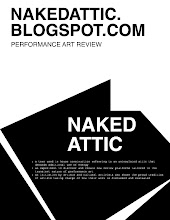Tuesday, Oct. 30th, Greene Naftali Gallery, New York
“A special live performance Tony Conrad, known for his pioneering work in music and underground cinema.” So, at least, it says in the program. Well, the performance wasn’t anything special, nor pioneering. In fact, the work seemed like an undergraduate course assignment on Hitchcock’s “Rear Window,” as seen from the backwaters of washed-out postmodern film theory.
Since barely anything happened, here’s a summary of the first few scenes:
Scene 1: We see nothing but a white drywall with a projection of a half-opened window.
Just in case we don’t get that it indeed is a ‘projection,’ we have to stare at it for about 10 minutes. Gradually, another window within the set appears, right behind the projected one—of course.
Scene 2: A door in the drywall opens a crack, and we see a very bright light shining through this door. Again, we wait, finally this door shuts.
Scene 3: We sit in darkness. At last, an additional window opens in the back of the set.
Yes, it is about windows, thank you for reminding us again. And, yes, even the title tells us that.
We see what looks like 3 young students, walking around inside of the set, pretending to be looking for something. Through loudspeakers, we hear the sound of squirting Windex across the imaginary floor and corners. Immediately, it’s obvious we are looking at people with no training in acting nor any careful instruction. Their movements hold no tension, are utterly self aware, and of course don’t look at all like the intended representational imitation of ‘regular people’ walking.
Then we have to listen to female heavy breathing coming out of the speakers.
To top all embarrassment, the chick gets naked. Well, at least we have something to look at. To keep things un-sexist, the boy gets naked too. Though he doesn’t have to wind around, caressing lightbulbs and cables, like she does. She wears a headset. Oh, so the heavy breathing might be hers. “Or is it just an illusion? Is life an illusion? Are we merely voyeurs?” Give me a break!
We go on seeing more young people, as well as an old man, getting naked, pseudo-modern dance, more projections, and even a Hitchcock-ish sound score. Well, here’s when I almost threw up: implying that the audience must be a crowd of utter idiots who still didn’t get the “Rear Window” reference, not only once, but twice, do we have to look at the actors staring at us through the window with binoculars! The second time was especially painful, because they just wouldn’t stop. Moreover, when people giggled in the audience, one of the actors couldn’t help but fall out of what pathetic little was left of her role, and giggled back.
All was accompanied by constant camera clicking. Why is it that the worst performances are the best documented?
I’ve endured for nearly an hour. I get up to leave.
The event is well visited, mostly by people in their twenties. The gallery reeks like the L-train, but only during its section from Chelsea to Williamsburg, maybe Bushwick if you want to be generous. Hipsters—and I mean hipsters, not artists—and other wannabes scan my outfit and pick at their faux-hawks. The Midtown view through the gallery windows is spectacular. We are being served homemade punch, water, and neatly arranged mini donut balls. I grab another one of those and flee.
Was this performance an underage, pretentious, busy-bee version of Performa’s disastrous opening event? (See a couple of posts below on Francesco Vezzoli’s “Cosi E (Se Vi Pare)/Right You Are If You Think You Are.”) It certainly was shallow, pseudo-intellectual, predictable, didactic, and painfully boring. In the case of the opening event, at least, the concern with topics such as the aura of fame/cult was acted out up by hired, experienced professionals. The night at Greene Naftali Gallery was held at the cost of naive, enthusiastic youngsters who didn’t get any credit whatsoever.
I can’t help but understanding the motivation for hosting this event as staying fresh (meat), though what I saw was as moldy as certain influential somebody's midlife crisis. I feel embarrassed for the poor amateur actors who had to be exposed to this scenester vampirism. I’m angry at Tony Conrad and the host for wasting people’s time and insulting their intelligence, but most of all for exploiting these poor kids for their underground capital.


































.jpg)